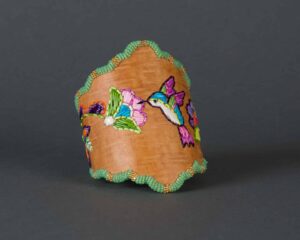Monica Raphael
Lesson: Language is a Legacy
A lot of the parents of our age, of my age people, they might experience going to boarding schools, and how they were told not to speak the language. While they were raising children of my era, they didn’t want to inflict things that they learned. They thought it might harm us if we spoke the language, so my era are really the people who really looked at things that were lost and tried to learn them.
I have a daughter who’s in her early 30s, and she can speak the language very well. Her husband can also speak the language. They work hard to make sure that their son can speak the language. All three of them, I consider, they can speak the language very much better than me. My daughter, in fact, is going to school to be a language teacher, to teach Anishinaabemowin. She’s in a program where she’s immersed in the language, so the whole training, they speak in Anishinaabemowin.
–Monica Raphael, Anishinaabe/Sičáŋğu Lakota
Theme: Relation and Continuation
Learning Objective: Students will consider reasons why Native languages and their speakers have declined and how artists like Monica Raphael are keeping Anishinaabemowin alive. Students will learn a few Anishinaabemowin words as they create art/color animals.
Background Information
Before European contact, it is estimated that there were over one thousand languages indigenous to the Americas; 300-500 in what is now called North America alone. According to the United States Census Bureau, using data collected from 2006-2010, 196 Native North American languages remain, with fewer than half a million speakers. Anishinaabemowin is estimated to have fewer than 8,500 speakers in the United States.
Through the boarding school initiative that began in the late 1800s, Native American children were forced to learn English and punished when they spoke their languages. After boarding schools started to be phased out in the 1930’s, the government began promoting urban relocation; promising help with housing and employment if Native Americans moved off of reservations and into major cities. This distance from cultural connections led to continued losses of tradition, culture, and language.
When Monica teaches workshops on quillwork, she uses Anishinaabemowin words for specific items and tools that she uses during the process. By repeatedly using the language as she instructs and by having labels with the words printed on them, Monica shares her knowledge and helps to keep Anishinaabemowin alive.
Activity
Language is one of the things that connects us to other people of our culture. Using the resources found at the following links, learn a few words of Anishinaabemowin and color the corresponding pages.
https://rmg.on.ca/wp-content/uploads/2022/07/Story-and-Song-Colouring-Book.pdf
https://scholar.uwindsor.ca/hhl_pubs/3/
Alternately, use the Ojibwe People’s Dictionary https://ojibwe.lib.umn.edu/ to look up Anishinaabemowin words and create a short, illustrated English to Anishinaabemowin dictionary.
Words you need to know
Inspiration
Something that causes a person to feel, think, or act in a certain way.
Relation
A reciprocal connection between two or more things, thoughts, ideas, or people.
Ceremony
The formal activities conducted on an important day or special occasion.
Tradition
A custom of belief shared by particular group, family, or society that has existed for a long time.
All Lessons By Monica
Lesson: Using Natural Dyes
Lesson: Sustainable Practices
Lesson: Language is a Legacy




